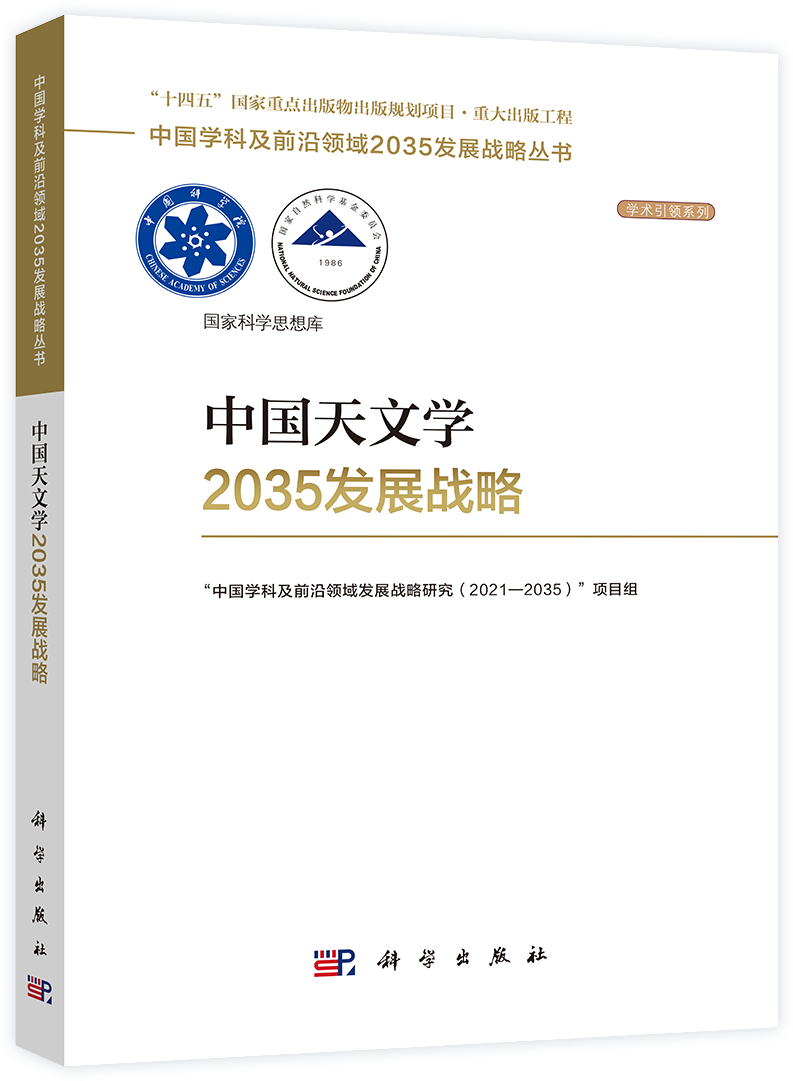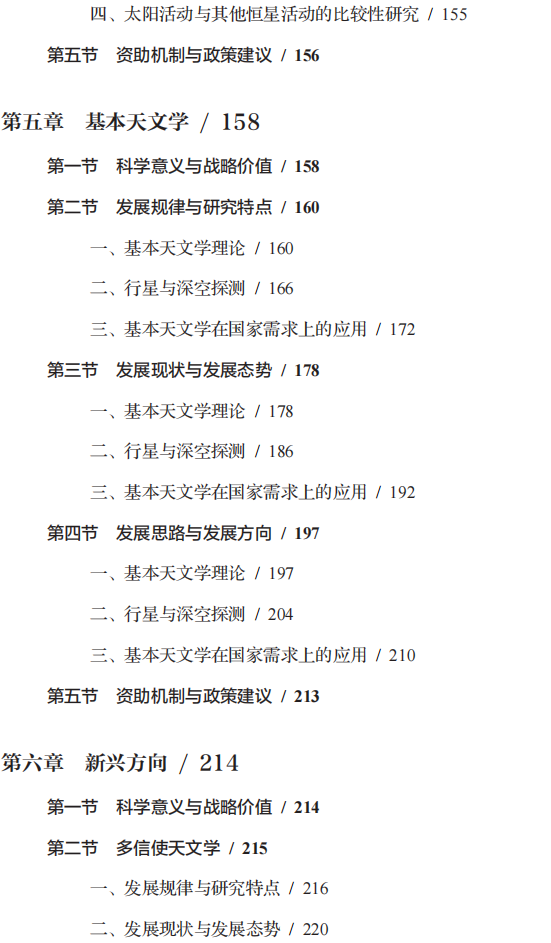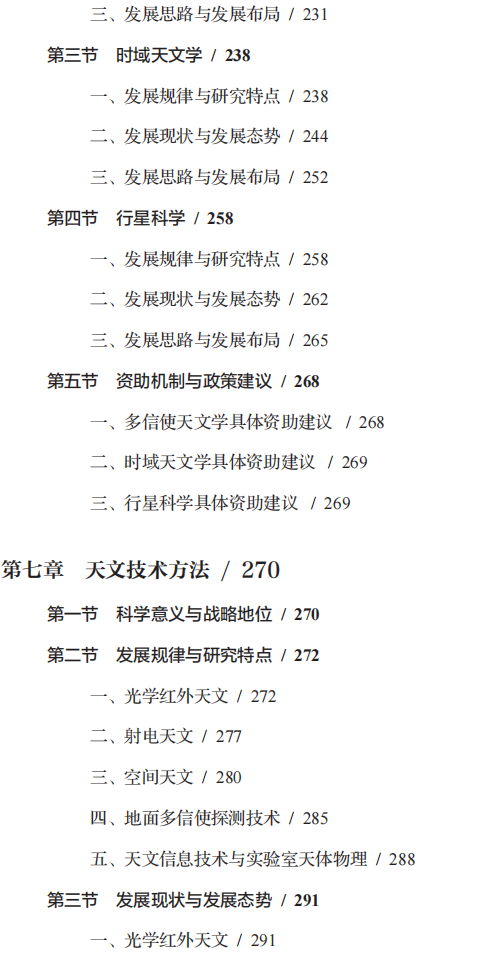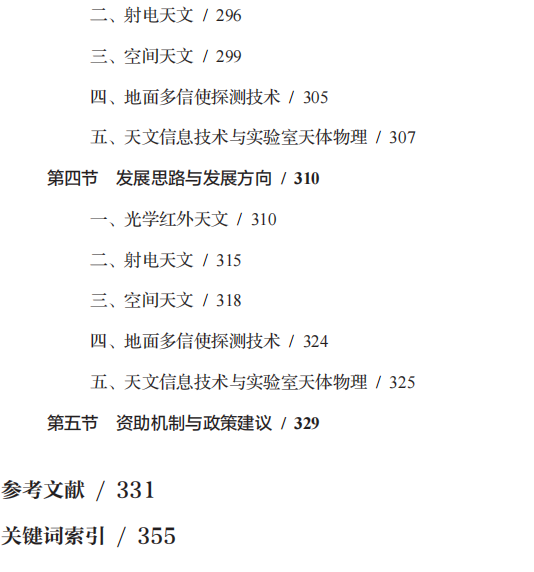


党的二十大胜利召开,吹响了以中国式现代化全面推进中华民族伟大复兴的前进号角。习近平总书记强调“教育、科技、人才是全面建设社会主义现代化国家的基础性、战略性支撑”,明确要求到 2035 年要建成教育强国、科技强国、人才强国。新时代新征程对科技界提出了更高的要求。当前,世界科学技术发展日新月异,不断开辟新的认知疆域,并成为带动经济社会发展的核心变量,新一轮科技革命和产业变革正处于蓄势跃迁、快速迭代的关键阶段。开展面向 2035 年的中国学科及前沿领域发展战略研究,紧扣国家战略需求,研判科技发展大势,擘画战略、锚定方向,找准学科发展路径与方向,找准科技创新的主攻方向和突破口,对于实现全面建成社会主义现代化“两步走”战略目标具有重要意义。
当前,应对全球性重大挑战和转变科学研究范式是当代科学的时代特征之一。为此,各国政府不断调整和完善科技创新战略与政策,强化战略科技力量部署,支持科技前沿态势研判,加强重点领域研发投入,并积极培育战略新兴产业,从而保证国际竞争实力。
擘画战略、锚定方向是抢抓科技革命先机的必然之策。当前,新一轮科技革命蓬勃兴起,科学发展呈现相互渗透和重新会聚的趋势,在科学逐渐分化与系统持续整合的反复过程中,新的学科增长点不断产生,并且衍生出一系列新兴交叉学科和前沿领域。随着知识生产的不断积累和新兴交叉学科的相继涌现,学科体系和布局也在动态调整,构建符合知识体系逻辑结构并促进知识与应用融通的协调可持续发展的学科体系尤为重要。
擘画战略、锚定方向是我国科技事业不断取得历史性成就的成功经验。科技创新一直是党和国家治国理政的核心内容。特别是党的十八大以来,以习近平同志为核心的党中央明确了我国建成世界科技强国的“三步走”路线图,实施了《国家创新驱动发展战略纲要》,持续加强原始创新,并将着力点放在解决关键核心技术背后的科学问题上。习近平总书记深刻指出:“基础研究是整个科学体系的源头。要瞄准世界科技前沿,抓住大趋势,下好‘先手棋’,打好基础、储备长远,甘于坐冷板凳,勇于做栽树人、挖井人,实现前瞻性基础研究、引领性原创成果重大突破,夯实世界科技强国建设的根基。”
作为国家在科学技术方面最高咨询机构的中国科学院和国家支持基础研究主渠道的国家自然科学基金委员会(简称自然科学基金委),在夯实学科基础、加强学科建设、引领科学研究发展方面担负着重要的责任。早在新中国成立初期,中国科学院学部即组织全国有关专家研究编制了《1956—1967 年科学技术发展远景规划》。该规划的实施,实现了“两弹一星”研制等一系列重大突破,为新中国逐步形成科学技术研究体系奠定了基础。自然科学基金委自成立以来,通过学科发展战略研究,服务于科学基金的资助与管理,不断夯实国家知识基础,增进基础研究面向国家需求的能力。2009 年,自然科学基金委和中国科学院联合启动了“2011—2020 年中国学科发展战略研究”。2012 年,双方形成联合开展学科发展战略研究的常态化机制,持续研判科技发展态势,为我国科技创新领域的方向选择提供科学思想、路径选择和跨越的蓝图。
联合开展“中国学科及前沿领域发展战略研究(2021—2035)”,是中国科学院和自然科学基金委落实新时代“两步走”战略的具体实践。我们面向 2035 年国家发展目标,结合科技发展新特征,进行了系统设计,从三个方面组织研究工作:一是总论研究,对面向2035 年的中国学科及前沿领域发展进行了概括和论述,内容包括学科的历史演进及其发展的驱动力、前沿领域的发展特征及其与社会的关联、学科与前沿领域的区别和联系、世界科学发展的整体态势,并汇总了各个学科及前沿领域的发展趋势、关键科学问题和重点方向;二是自然科学基础学科研究,主要针对科学基金资助体系中的重点学科开展战略研究,内容包括学科的科学意义与战略价值、发展规律与研究特点、发展现状与发展态势、发展思路与发展方向、资助机制与政策建议等;三是前沿领域研究,针对尚未形成学科规模、不具备明确学科属性的前沿交叉、新兴和关键核心技术领域开展战略研究,内容包括相关领域的战略价值、关键科学问题与核心技术问题、我国在相关领域的研究基础与条件、我国在相关领域的发展思路与政策建议等。
三年多来,400 多位院士、3000 多位专家,围绕总论、数学等18 个学科和量子物质与应用等 19 个前沿领域问题,坚持突出前瞻布局、补齐发展短板、坚定创新自信、统筹分工协作的原则,开展了深入全面的战略研究工作,取得了一批重要成果,也形成了共识性结论。一是国家战略需求和技术要素成为当前学科及前沿领域发展的主要驱动力之一。有组织的科学研究及源于技术的广泛带动效应,实质化地推动了学科前沿的演进,夯实了科技发展的基础,促进了人才的培养,并衍生出更多新的学科生长点。二是学科及前沿领域的发展促进深层次交叉融通。学科及前沿领域的发展越来越呈现出多学科相互渗透的发展态势。某一类学科领域采用的研究策略和技术体系所产生的基础理论与方法论成果,可以作为共同的知识基础适用于不同学科领域的多个研究方向。三是科研范式正在经历深刻变革。解决系统性复杂问题成为当前科学发展的主要目标,导致相应的研究内容、方法和范畴等的改变,形成科学研究的多层次、多尺度、动态化的基本特征。数据驱动的科研模式有力地推动了新时代科研范式的变革。四是科学与社会的互动更加密切。发展学科及前沿领域愈加重要,与此同时,“互联网 +”正在改变科学交流生态,并且重塑了科学的边界,开放获取、开放科学、公众科学等都使得越来越多的非专业人士有机会参与到科学活动中来。
“中国学科及前沿领域发展战略研究(2021—2035)”系列成果以“中国学科及前沿领域 2035 发展战略丛书”的形式出版,纳入“国家科学思想库 - 学术引领系列”陆续出版。希望本丛书的出版,能够为科技界、产业界的专家学者和技术人员提供研究指引,为科研管理部门提供决策参考,为科学基金深化改革、“十四五”发展规划实施、国家科学政策制定提供有力支撑。
在本丛书即将付梓之际,我们衷心感谢为学科及前沿领域发展战略研究付出心血的院士专家,感谢在咨询、审读和管理支撑服务方面付出辛劳的同志,感谢参与项目组织和管理工作的中国科学院学部的丁仲礼、秦大河、王恩哥、朱道本、陈宜瑜、傅伯杰、李树深、李婷、苏荣辉、石兵、李鹏飞、钱莹洁、薛淮、冯霞,自然科学基金委的王长锐、韩智勇、邹立尧、冯雪莲、黎明、张兆田、杨列勋、高阵雨。学科及前沿领域发展战略研究是一项长期、系统的工作,对学科及前沿领域发展趋势的研判,对关键科学问题的凝练,对发展思路及方向的把握,对战略布局的谋划等,都需要一个不断深化、积累、完善的过程。我们由衷地希望更多院士专家参与到未来的学科及前沿领域发展战略研究中来,汇聚专家智慧,不断提升凝练科学问题的能力,为推动科研范式变革,促进基础研究高质量发展,把科技的命脉牢牢掌握在自己手中,服务支撑我国高水平科技自立自强和建设世界科技强国夯实根基做出更大贡献。
“中国学科及前沿领域发展战略研究(2021—2035)”
联合领导小组
2023 年 3 月
2019年底,国家自然科学基金委员会与中国科学院决定合作开展2021~2035年中国学科及前沿领域发展战略研究工作。这次战略研究对谋划相关学科的未来发展具有重要意义,将对我国基础研究的长远发展产生深远的影响。
按照国家自然科学基金委员会和中国科学院的部署,这次的天文学学科发展战略研究要突出前瞻性、强化战略性、确保专业性和注重普及性。前瞻性是指研究报告要立足当前,展望未来5~15年天文学学科的发展趋势;战略性是指研究报告要将科学自身的发展规律与国家经济社会发展的需求有机结合起来;专业性是指研究报告要建立在数据准确和资料翔实的基础上;普及性是指研究报告既要面向科学界又要注意面向公众。在国家自然科学基金委员会和中国科学院的领导下,2020年3月25日成立了由6位院士和11位资深天文学家组成的天文学学科发展战略专家组,以及由17名在第一线从事天文学研究的中青年学术骨干组成的秘书组,目标是在 2020年内完成 2021~2035年中国天文学学科发展战略研究报告。结合天文学学科的实际情况,专家组和秘书组共同商定了研究报告的基本内容,包括以下7章:学科总论,星系宇宙学,恒星、银河系及星际介质,太阳物理,基本天文学,新兴方向,天文技术方法。
在一年多的时间里,专家组和秘书组按照天文学的不同层次和对象,即星系宇宙学,恒星、银河系及星际介质,太阳物理,基本天文学,新兴方向,天文技术方法6个方面,进行了详细的调查、分析和战略研究。2020年3月的项目启动会对6个方面的撰写工作进行了总体讨论和框架设计,随后在广泛调研的基础上形成了各章节大纲,于2020年5月初完成了初稿。在随后几个月的时间里又进行了多次讨论和修改,初稿于2020年底完成。
本书作者认为,近年来,我国对天文学研究经费的投入大幅增加,天文学研究和教育有了长足的发展,逐步形成了从人才培养、仪器设备研制、观测和理论研究到应用服务的较为完整的体系,形成了一批在国内外有影响的学术带头人和优秀创新研究群体,研究队伍的年龄结构趋于合理。大天区面积多目标光纤光谱望远镜(Large Sky Area Multi-Object Fiber Spectroscopic Telescope,LAMOST,又名郭守敬望远镜)、500m 口径球面射电望远镜(Fivehundred-meter Aperture Spherical radio Telescope,FAST)、暗物质粒子探测卫星(Dark Matter Particle Explorer,DAMPE)、硬X射线调制望远镜(Hard X-ray Modulation Telescope,HXMT)等的建成,标志着我国天文仪器的研制水平显著提升。我国天文学研究已经取得一批在国际上有相当显示度的成果,总体水平在发展中国家中位居前列,成为国际上一支不可忽视的力量。但是,也应该看到,目前我国天文设备研究和教育的水平同发达国家相比,仍然存在很大差距。基于这样的认识,本书建议我国天文学到2035年的发展目标是:在若干个领域建成引领国际天文学发展的重大设施,广泛参与国际天文学合作项目,并引领若干个重大国际观测项目以及国际大型科学设施的建设,产生若干引领型的科学大家,解决若干个重大的天文学科学问题,在国家安全方面贡献重要力量,在航天和深空探测等领域发挥重要支持作用。
本书凝聚了许多院士和专家学者的智慧与努力,不仅对国内外天文学的发展现状和态势进行了详细评述,还对未来15年我国天文学的发展战略和措施提出了一些重要的、有意义的思考与建议。我们希望它能为各级领导和部门决策提供参考,对从事各类天文学研究和教育的人员有所启迪,对研究生和大学生的入门与成长有所帮助。未来15年,我国天文学的发展充满巨大的机遇和挑战,如果本书能对我国天文学的发展起到一点促进作用,便是对我们极大的欣慰。
最后,真诚地感谢热心参与本书撰写工作、提供材料和建议的所有院士和专家学者,感谢国家自然科学基金委员会和中国科学院领导的指导与关心。
景益鹏
《中国天文学2035发展战略》项目组组长
2023年3月
天文学是一门探索宇宙中天体起源和演化的基础学科,其研究对象涵盖各个层次的天体。天文学科是人类认识宇宙的“排头兵”,在国家学科发展布局中占据基础地位,有力地促进了其他自然科学和尖端技术的发展,同时其研究对象也与人类生存和国家安全等密切相关。天文学创新水平已成为各国特别是大国科技实力的综合体现和重要标志,中国天文学的发展得到党和国家领导人的高度重视与肯定。
按照研究对象,天文学可以分为五个研究领域:星系宇宙学,恒星、银河系及星际介质,太阳物理,基本天文学,以及包括系外行星、引力波及其对应体、粒子天体物理等在内的新兴方向。天文技术方法作为支撑天文学发展的技术基础,是天文学研究的组成部分。天文学是一门观测与理论紧密结合、相互促进的学科。天文观测验证、丰富和发展已有的理论框架乃至催生新的理论体系,同时为大量观测的高度量化总结和升华的理论框架的建立以及更深刻地了解新发现确立了新的高度。天文学与其他学科深度交叉,其他学科的知识是解释复杂天文现象的重要工具,同时天文发现和理论又促进其他学科的进步。
天文学一直是世界各科技强国的重点发展学科,世界各科技强国高度重视天文学人才培养、科研队伍建设、观测设备建造以及创新科研环境培育。2010~2019年,我国天文学研究有了长足的发展,人才队伍结构更加合理、规模不断扩大、质量显著提高,研究领域涵盖理论、观测和仪器设备研制等众多方向,在国际核心期刊上发表的论文数量大幅增加,国际上有较高显示度和影响的成果显著增加。我国天文学家还担任了国际天文学联合会(International Astronomical Union,IAU)副主席和专业委员会主席等重要职务。总体而言,我国天文学的研究水平在发展中国家中位居前列,我国天文学研究团队是国际上一支不可忽视的力量。在人才队伍方面,本书收集各相关单位的数据汇总后可知,截至2019年12月,我国有一支由约2500名固定职位人员和约2500名流动人员(博士后、博士研究生、硕士研究生)组成的天文学研究队伍,其中具有正高级职称的600余人,副高级职称的900人左右,博士后200余人,博士研究生近1200人,硕士研究生近1200人。本书委托中国科学院文献情报中心基于美国科学情报研究所(Institute for Scientifc Information,ISI)的Web of Science数据库的统计,2015~2019年天文学领域获资助的项目共约5600项,金额近150亿元。这五年间,天文学学科领域共计产出研究论文68 422篇,累计论文量增幅为
10.7%,我国在这一时期以第一作者发表5786篇论文,占国际论文总数的8.46%,世界排名第二位。以国际天文学联合会的会员数作为参考,我国天文学家的人均论文产出高于世界平均水平。从学科指数这一指标来看,我国天文学研究在整个国家科研队伍中的占比相对较低,以美国、日本以及欧洲等发达国家和地区的学科队伍作为参考,天文学研究队伍应该扩大两倍以上。天文学的高影响论文主要出自一流的大科学装置,而我国目前的天文大科学装置的建设还处于起步阶段,导致由我国学者主导的论文(第一作者论文)影响力偏弱,天文学科的篇均被引频次是该学科世界篇均被引频次的一半。2010~2019年,我国在地面多个波段以及空间设备方面都建成了一批有特色的重要设备,形成了有一定国际竞争力的实测基础,包括LAMOST、FAST、天马望远镜,以及“悟空”号DAMPE、“慧眼”HXMT等。
天文学探索天体的起源和演化。随着探测技术的不断进步,已有的科学问题被重塑,同时新的科学问题被提出。天文学的关键科学问题是天文学发展的引擎,也是科学驱动的基础。未来5~15年天文学的关键科学问题包括:①暗物质和暗能量的本质以及星系的形成与演化机制;②恒星及银河系的结构和演化机制;③太阳在不同尺度上的结构及其爆发机制;④行星的形成、探测及动力学特性;⑤面向下一代望远镜的关键技术。
针对上述关键科学问题,我国天文学的总体发展思路包括以下方面。
(1)依托已建的重大科学设施,开展前沿科学研究。未来5~15年,围绕已建设备,开展系统性的、前沿的科学研究。基于LAMOST巡天的海量光谱观测数据,开展丰度异常恒星、大样本双星、致密天体等的起源和演化研究;整合LAMOST中高分辨率巡天、星震学数据以及盖亚(Gaia)数据,耦合银河系的化学与运动学研究,建立银河系演化的图像。通过FAST多科学目标扫描巡天,同时获取脉冲星和中性氢(neutral hydrogen)的海量数据,推动射电宇宙学和星系演化研究,系统性搜寻和大样本统计分析各种致密天体及其爆发(如快速射电暴)现象。基于“悟空”号DAMPE持续增加的高质量数据,获得世界上最精确的20 GeV~10 TeV电子宇宙射线能谱、50 GeV至数百TeV的质子与氦核宇宙线能谱以及能段最宽的硼碳比例能谱,在暗物质间接探测和宇宙线研究方面取得突破性成果。基于“慧眼”HXMT,系统获得一批致密星的高能时变和能谱演化特征,理解致密天体的吸积过程、爆发过程、相对论喷流以及辐射机制。
(2)发展自主的大科学设置,力争在若干领域引领国际前沿。大科学装置的缺乏是影响我国天文学发展的一个关键因素,谋划下一代大科学装置是未来我国天文学发展的重要条件。中长期,我国计划建成如下重大科学设施:载人空间站工程巡天空间望远镜(Chinese Space Station Telescope,CSST)、500 m口径球面射电望远镜阵列(FAST Array,FASTA)、南极昆仑站光学红外大视场巡天望远镜和亚毫米波望远镜、大型光学红外望远镜(Large Optical-Infrared Telescope,LOT)、6.5 m宽视场光谱巡天望远镜(Multiplexed Survey Telescope,MUST)、大口径亚毫米波望远镜、巨型太阳望远镜、天问4号木星探测器、宇宙热重子探寻(Hot Universe Baryon Surveyor,HUBS)计划、新疆奇台110 m口径全可动射电望远镜(Qitai Telescope,QTT)、12 m级大视场光谱巡天望远镜(Twelve-meter Multi-Object Spectroscopic Telescope,TMOST)、紫外发射线成图探索小卫星(Census of Warm-Hot Intergalactic Medium,Accretion,Feedback Explorer,CAFE)等。
(3)参与国际大科学装置的建设。国际合作是现代天文学研究的重要方式,同时会进一步促进我国天文技术的进步。基于国际设备开展的多波段天文观测也是提升我国天文研究水平的重要途径。中长期,我国将参与若干个重大国际天文大科学装置的建设。平方千米(射电望远镜)阵(Square Kilometer Array,SKA)是一个巨型射电望远镜阵列,其有效集光面积达1 km2。我国是SKA的七个创始成员国之一。SKA的研究对象覆盖宇宙各层次的天体,将开启射电天文学研究的新里程。30 m望远镜(Thirty-meter Telescope,TMT)是一个为国际合作准备建设的口径达30 m的光学/红外望远镜,是世界三大30 m级别的光学望远镜之一,与我国已有的光学/红外设施形成有效的互补,提供高空间分辨率、高光谱分辨率、高灵敏度的观测,TMT将是未来5~15年光学/红外天文发展的主力之一。
(4)重视理论研究,发展数值模拟天文学。我国的天文学研究在理论和数值模拟方面有着优良的传统,在国际上占据重要地位。中长期,我国将继续大力发展理论研究和数值模拟天文学。
依据总体思路,未来我国天文学的发展目标包括:①依托已建设备,开展大规模星系巡天,理解暗能量和早期宇宙的本质,发展暗物质粒子候选者的探测方法,推动星系大生态环境的观测研究;②基于LAMOST巡天,结合国际多波段的巡天,建立银河系演化的图像;③建设国家观测平台,对太阳实现厘角秒级的观测,在空间天气学领域取得突破;④参与月球、火星、小行星和木星的深空探测,探索太阳系中水以及其他生命物质存在的可能性,揭示太阳系起源及其生命起源等问题;⑤建设完备的多信使和时域观测网络,深入探索“极端宇宙”;⑥建设完成数个国际顶尖的大科学装置,通过国际合作参与若干个国际大科学装置建设。
围绕关键科学问题,根据总体思路及发展目标,天文学未来的重要研究方向包括:①宇宙起源及暗物质和暗能量的本质;②宇宙大尺度结构及星系的形成与演化;③超大质量黑洞与星系核区活动;④银河系的形成历史、结构与演化;⑤恒星形成、结构和演化及星际介质;⑥恒星灾变爆发机制、致密天体的形成和演化;⑦太阳精细结构特征及日冕加热的机制;⑧太阳磁场的产生、储能及释能的物理机制与预报;⑨行星系统的形成、探测和动力学;⑩时空参考系、轨道动力学及其应用;光学/红外/紫外关键技术和方法;射电/毫米波/亚毫米波关键技术和方法;?高能辐射和粒子探测关键技术与方法。
最后,形成如下资助机制与政策建议。①推动LOT等装置的预研、立项和建设。科学驱动下的重大设施建设对天文学的发展至关重要,未来5~15年要确保建成一批重大科学装置,为我国天文学的进一步发展奠定坚实的基础。②围绕已建重大观测设备的科学研究,设立项目群和研究中心。由于我国长期以来缺乏有竞争力的天文观测设备,天文学家一直以使用国外天文观测设备的存档数据或者少量地利用国外观测设备开展研究为主,因此十分有必要引导和鼓励我国学者逐步利用中国刚刚投入运行或者即将投入运行的重大观测设备开展研究。③加强面向重大科学问题的终端科学仪器的研制和优化使用。不同于望远镜本体,终端科学仪器更新换代的步伐更快,一般为10年,这可以充分利用新的技术来探索新的科学问题或深入回答已有的科学问题。国际大型天文设备的仪器配置通常分为三个阶段,即建设“一代”、规划“二代”、前瞻“三代”。目前我国的望远镜口径、数量都有限,应大力支持面向重大科学问题研制访问终端仪器,用于国际先进望远镜观测平台上,使得中国天文学家有机会争取到更多的国际望远镜观测时间,实现中国天文学家自己的科学目标。④加强计算天体物理学研究。计算机模拟(或数值实验)研究在理论研究和指导天文观测方面发挥着巨大的作用。我国应当积极与国内计算科学界合作,发展自主的模拟程序,充分发挥国内先进超算中心计算能力的优势,在一些天体物理领域取得国际领先的模拟成果和理论成果,并为国家天文大科学工程项目提供科学支撑。⑤支持国际观测合作项目以及国际大型观测设备的合作。积极开展国际合作可以弥补我国在设备类型、波段、探测能力等方面的不足,是实现学科发展目标的一个重要途径。随着一批新的国际地面和空间设备的出现,支持国际合作项目成为为我国学者提供前沿研究条件的一种必然需求。具体的合作可以包括:参加专题性的国际联网观测;分享国际望远镜观测时间;支持参与(主持)大型国际地面和空间观测计划;支持竞争国际开放设备的时间;支持双边或多边的观测课题合作。⑥引进人才,发展高校天文教育,壮大天文研究队伍。近年来,我国天文研究队伍的体量和质量都在迅速上升且更趋于年轻化,但在国际上我国的研究队伍体量还小于法国、意大利等发达国家,与我国经济总量已居世界第二的地位还很不相称;在国内与其他数理学科,尤其是物理学相比,体量仍然太小。要继续呼吁科技界和教育界充分认识天文学作为自然科学六大基础学科之一的科学与社会作用,通过国家基础科学人才培养基金等专项基金的支持,发展高校天文科研和教育人才。⑦促进新兴方向研究。新兴天文学包括多信使天文学、时域天文学和行星科学三个主要方向。与国际先进水平相比,我国新兴方向的人才队伍严重不足,必须积极促进新兴方向观测和理论研究的大力发展。⑧促进交叉研究。天文学研究的主流是天体物理,天文学与物理学的交叉融合变得越来越重要。未来我国要进一步加强天文学与物理学、地学、力学、数学和信息学的交叉研究,特别是粒子物理与宇宙学、天体物理与原子核物理、天体物理与等离子体物理和磁流体力学、天体物理与实验室等离子体、天体物理与计算科学、天体物理与地球科学等的交叉研究。⑨建议基金项目一定比例的论文在国内期刊发表研究成果。我国缺乏高影响力的天文学专业期刊,为了进一步促进我国天文学的发展,增强我国天文学的国际影响力,鼓励一定比例的重要成果,特别是基于我国大科学装置的核心工作成果发表在国内期刊上,推动《天文和天体物理学研究》《中国科学:物理学力学天文学》等国内期刊成为国际主流天文学期刊。同时,建议在项目结题考核环节实行代表作评价制度,代表作至少应包括一篇在国内期刊上发表的论文。
Abstract
Astronomy is a fundamental discipline that explores the origin and evolution of celestial bodies in the universe. Its research objects cover celestial bodies at all levels. Astronomy is the “vanguard” of human understanding of the universe, occupying a basic position in the national discipline development layout, and has effectively promoted the development of other natural sciences and cutting-edge technologies. At the same time, its research objects are also closely related to human life and national security. The innovation level of astronomy has become a comprehensive manifestation and an important symbol of the scientific and technological strength of countries, especially major countries. The development of Chinese astronomy has been highly valued and recognized by the leaders of the Party and the country.
According to its research objects, astronomy can be divided into five research fields: extragalactic astronomy and cosmology, stars, the Milky Way and interstellar medium, solar physics, fundamental astronomy, and emerging fields including exoplanets, gravitational waves, along with its electro-magnetic counterparts, and particle astrophysics. Astronomy technologies and methods, as a technical foundation supporting the development of astronomy, are an integral part of astronomical research.Astronomy is a disciplinary subject that combines observation and theory, and mutually promotes each other. Astronomical observations not only verify, enrich, and develop the existing theoretical frameworks, but also give rise to new theoretical systems. Meanwhile as the highly quantitative summary of massive observations, the establishment of theoretical frameworks establishes a new height for a deeper understanding of new discoveries. Astronomy deeply intersects with other subjects, and knowledge from other subjects is an important tool to explain complex astronomical phenomena. At the same time, astronomical discoveries and theories also promote the progress of other subjects.
Since astronomy has always been a key development discipline for the world’s major scientific and technological powerhouse, these countries attach great importance to talent cultivation, research team building, observation equipment construction, and innovative research environment cultivation in the astronomy field. From 2010 to 2019, astronomical research in China has made significant progress, with a more reasonable structure of talent teams and expanding number of astronomers. The research fields cover many directions including theory, observation, and instrument development. The number of papers published in the international core journals has increased significantly, and the number of internationally highly-visible and influential achievements has also increased significantly.Chinese astronomers have gained important positions such as Vice Chairman and Chair of Professional Committees of the International Astronomical Union (IAU). Overall, astronomical research level of China ranks among the top in the developing countries, and its astronomical research team is a significant force in the international arena. As for talent teams, according to data collected from various related units, as of December 2019, there is a Chinese astronomical research team composed of about 2,500 permanent employees and about 2,500 other employees (postdoctoral researchers, doctoral students, and master-degree students), including over 600 persons with senior professional titles and 900 persons with associate senior professional titles. There are also more than 200 postdoctoral researchers, nearly 1,200 doctoral-degree students, and nearly 1,200 masterdegree students. According to statistics from the Web of Science database compiled by the Institute of Scientific Information (ISI) commissioned by the authors of this book, in the astronomy field, about 5,600 projects have been funded in the five years from 2015 to 2019, totaling nearly RMB 15 billion. In this period, the astronomy disciplinary field produced a total of 68,422 research papers, with a cumulative growth rate of 10.7%. China published 5,786 papers as the first author, accounting for 8.46% of the total number of international papers, ranking second in the world. With the number of the members of the International Astronomical Union as a reference, the per capita paper output of Chinese astronomers is higher than the world average level. From the indicator of the disciplinary index, astronomical research team in China accounts for a relatively small proportion of the entire national scientific research team. Compared with the developed countries and regions such as the United States, Japan, and Europe, the astronomical research team should be expanded to more than twice the current size. The highly influential papers in astronomy are mainly produced by first-class large scientific devices, and the construction of astronomical large scientific devices in China is still in the initial stage, which has resulted in a weak impact of papers led by Chinese scholars (first-author papers), and the average citation frequency in astronomy research papers is half of that of the world. From 2010 to 2019, China has built a number of characteristic and important devices in multiple bands on the ground and in space, forming a certain degree of international competitiveness on an observational basis, including the Large Sky Area Multi-Object Fiber Spectroscopic Telescope(LAMOST), the Five-hundred-meter Aperture Spherical radio Telescope (FAST), the Tian Ma Telescope, the Dark Matter Particle Explorer(DAMPE), the Dark Matter Particle detection satellite, and the insight Hard X-ray Modulation Telescope.
Astronomy explores the origin and evolution of celestial bodies. With the continuous advancement of detection technology, the existing scientific questions are reshaped while new scientific questions arise. The key scientific questions in astronomy are the engine for the development of astronomy and the foundation of the scientific driving force. The key scientific questions in astronomy for the next 5-15 years include: ① the nature of dark matter and dark energy and the formation and evolution mechanisms of galaxies; ② the structure and evolution mechanisms of stars and the Milky Way; ③ the structure of the sun on different scales and its eruption mechanism; ④ the formation, detection, and dynamic characteristics of planets; ⑤ key technologies for the next generation of telescopes.
In response to the above key scientific questions, the overall development strategy of Chinese astronomy includes the following aspects.
(1) To carry out cutting-edge scientific research based on the existing major scientific facilities. In the next 5-15 years, systematic and cuttinggedge scientific research will be conducted around the established equipment. Based on the massive spectral observation data obtained through the LAMOST survey, the origin and evolution of abundance anomalous stars, large sample binary stars, and compact celestial bodies will be studied. The chemical and kinematic research of the Milky Way will be coupled by integrating intermediate to high-resolution survey data, asteroseismology data, and Gaia data. The evolution of the Milky Way will be established. Through the multi-purpose scanning survey of FAST, massive data on pulsars and neutral hydrogen (HI) will be obtained, which will promote radio cosmology and galaxy evolution research, systematical search and large-sample statistical analysis of various compact celestial bodies and their outbreak phenomena (such as fast radio bursts). Based on the continuously increasing high-quality data of the DAMPE, the world’s most accurate 20 GeV-10 TeV electron cosmic ray energy spectrum, a proton and helium cosmic ray energy spectrum of 50 GeV to several hundred TeV, and the widest range of boron and carbon ratio energy spectrum will be obtained. Moreover, breakthrough achievements in the indirect detection of dark matter and cosmic ray research will be achieved. Based on the HXMT, a series of high-energy variability and spectral evolution characteristics of compact stars will be obtained, which will help to understand the accretion process,eruption process, relativistic jets, and radiation mechanisms of compact celestial bodies.
(2) To develop independent major scientific facilities to lead the international frontier in several areas. The lack of such facilities is a crucial bottleneck affecting the development of astronomy in China. Planning for the next generation of major scientific facilities is an essential condition for the future development of astronomy in China. In the medium to long term, China plans to build the following major scientific facilities: the Chinese Space Station Telescope (CSST), the Five-hundred-meter Aperture Spherical Telescope Array (FAST array, FASTA), the Kunlun Station Optical and Infrared Large Field of View Sky Survey Telescope and Submillimeter Telescope in Antarctica, the Large Optical-Infrared Telescope (LOT), the 6.5-meter Multiplexed Survey Telescope (MUST), the Large Aperture Submillimeter Telescope, the Giant Solar Telescope, the Tianwen-4 Jupiter Probe, the Hot Universe Baryon Surveyor (HUBS) project, the Qitai Telescope(QTT) with a 110-meter aperture and full mobility, the Twelve-meter Multi-Object Spectroscopic Telescope (TMOST), and the Census of Warm-Hot Intergalactic Medium, Accretion, Feedback Explorer (CAFE) small satellite for exploring ultraviolet emission lines.
(3) To participate in the construction of international major scientific facilities. International cooperation is an important way for modern astronomy research, and it will further promote the development of China’s astronomical technology. Multi-band astronomical observations based on international facilities are also an important way to improve China’s astronomical research level. In the medium and long term, China will participate in the construction of several major international astronomical facilities. The Square Kilometer Array (SKA) is a giant radio telescope array, with an effective collecting area of 1 square kilometer. China is one of the seven founding members of SKA. The targets of SKA cover celestial bodies at all levels in the universe, opening up a new era of radio astronomy research. The Thirty Meter Telescope (TMT) is a 30-meter optical/infrared telescope under international cooperation preparation. It is one of the world’s three 30-meter-class optical telescopes,and complements China’s existing optical/infrared facilities, providing high spatial resolution, high spectral resolution, and high sensitivity observations. The TMT will be one of the main forces for the development of optical/infrared astronomy in the next 5-15 years.
(4) To emphasize theoretical research and the development of numerical simulation astronomy. China’s astronomical research has a strong tradition and occupies an important position internationally in terms of theoretical and numerical simulation research. In the medium and long term, China will continue to vigorously promote the theoretical research and development of numerical simulation astronomy.
According to the overall plan, the development goals of China’s astronomy in the future include: ① relying on the existing facilities, carry out large-scale galaxy surveys, understand the nature of dark energy and the early universe, develop detection methods for dark matter particle candidates, and promote the observation and research of the large ecological environment of galaxies;②establish an image of the evolution of the Milky Way based on the LAMOST survey and international multiband surveys; ③ establish a national observation platform and achieve centiarcsecond-level observations of the sun, making breakthroughs in the field of space weather; ④ participate in deep space exploration of the moon, Mars, asteroids, and Jupiter, explore the possibility of water and other life materials in the solar system, and reveal issues such as the origin of the solar system and the origin of life; ⑤ build a complete multi-messenger and time-domain observation network, and delve into the “extreme universe”; ⑥ build and complete several internationally top scientific facilities, and participate in the construction of several international major scientific facilities through international cooperation.
Based on the key scientific questions,the overall plan and development goals, the important research directions of astronomy in the future include: ① the origin of the universe, and the nature of dark matter and dark energy; ② the large-scale structure of the universe, and the formation and evolution of galaxies; ③ supermassive black holes and the activity in the nuclei of galaxies; ④ the formation history, structure, and evolution of the Milky Way; ⑤ star formation, stellar structure, and evolution of star, as well as interstellar matter; ⑥ stellar explosions,and the formation and evolution of compact object; ⑦ the fine structural features of the sun and the mechanisms of coronal heating; ⑧ the physical mechanisms for the generation, storage, and release of solar magnetic fields, as well as their prediction; ⑨ the formation, detection, and dynamics of planetary systems; ⑩ space-time reference systems, orbital dynamics, and their applications; ?key technologies and methods in optical/infrared/ultraviolet astronomy; ?key technologies and methods in radio millimeter/submillimeter; ?key technologies and methods for high-energy radiation and particle detection.
Finally, the following funding mechanisms and policy proposals have been formed.
(1) To promote the pre-research, project approval, and construction of facilities such as LOT. The construction of facilities driven by scientific research is crucial for the development of astronomy. It is essential to ensure that a batch of major scientific facilities is built within the next 5-15 years to lay a solid foundation for the further development of astronomy in China.
(2) To establish research centers and group research programs for scientific research around established major observing equipment. Due to the lack of competitive astronomical observation equipment in China, astronomers have mainly relied on foreign archived data or a small number of foreign observation equipment for research. Therefore, it is essential to encourage Chinese scholars to use the major observation equipment that China has recently put into operation or is about to put into operation, to carry out research.
(3) To strengthen the development and optimization of terminal scientific instruments oriented to major scientific issues. Unlike the telescope body, the pace of updating the terminal scientific instruments is faster, usually every 10 years. This can fully utilize new technology to explore new scientific issues or answer the existing scientific questions. The instrument configuration of international large-scale astronomical equipment is usually divided into three phases: construction of “generation one”, planning of “generation two”, and prospecting of “generation three”. Currently, China’s telescope diameter and quantity are limited. It is necessary to vigorously support the development of terminal instruments for major scientific issues, to be used on international advanced telescope observation platforms, giving Chinese astronomers the opportunity to compete for more international telescope observation time and achieve their own scientific goals.
(4) To strengthen research in computational astrophysics. Computer simulation (or numerical experiment) research plays a significant role in theoretical research and guiding astronomical observations. China should actively cooperate with the domestic computational science community, develop independent simulation programs, fully utilize the computing power of advanced national supercomputer centers, and gain international leading simulation results and theoretical achievements in some astrophysics fields, providing scientific support for national astronomical facilities.
(5) To support international observation cooperation projects and cooperation on international large-scale observation equipment. Active international cooperation can compensate for China’s shortcomings in equipment types, bandwidth, and detection capabilities, and is an important way to achieve disciplinary development goals. With the emergence of a new batch of international ground and space equipment, supporting international cooperation projects is an inevitable requirement to provide Chinese scholars with cutting-edge research conditions. Specific cooperation can include: participating in international network observation on specific research topics; sharing international telescope observation time; supporting participation (hosting) in large-scale international ground and space observation plans; supporting competition for international open equipment time; and supporting bilateral or multilateral observation project cooperation.
(6) To recruit talents, develop university astronomy education, and strengthen the astronomy research team. In recent years, the size and quality of China’s astronomical research teams have been rapidly increasing and tending toward younger generations. However, in terms of the size of the research teams, China’s volume is still smaller than that of developed countries such as France and Italy, which is not commensurate with China’s status as the world’s second-largest economy country. It is necessary to continue calling on the science and educational sectors to fully recognize the societal impact of astronomy as one of the six fundamental natural sciences, and support university astronomy research and education talents through dedicated funds.
(7) To promote research in emerging areas. Emerging astronomy includes three main areas: multi-messenger astronomy, time-domain astronomy, and planetary science. Compared with international counterparts, China’s talent team in emerging field is severely lacking.It is necessary to actively promote the development of emerging field observations and theoretical research.
(8) To promote interdisciplinary research. The mainstream of astronomical research is astrophysics, and the fusion of astronomy with physics has become increasingly important. In the future, China should further strengthen the interdisciplinary research between astronomy and physics, geology, mechanics, mathematics, and informatics, especially the interdisciplinary research between particle physics and cosmology, astrophysics and nuclear physics, astrophysics and plasma physics with magnetohydrodynamics, astrophysics and laboratory plasma, astrophysics and computational science, and astrophysics and earth science.
(9) To encourage that a certain proportion of research results published in domestic journals should be included in the funding project. China lacks high-impact astronomical journals. In order to further promote the development of China’s astronomy, enhance China’s international influence in astronomy, and encourage important achievements, especially those based on China’s major scientific facilities should be published in domestic journals such as Research in Astronomy and Astrophysics, Science China:Physics,Mechanics & Astronomy, promoting these journals to become mainstream international astronomical journals. At the same time, it is recommended to implement a representative work evaluation system in the project completion assessment, and the representative work should include at least one paper published in a domestic journal.






